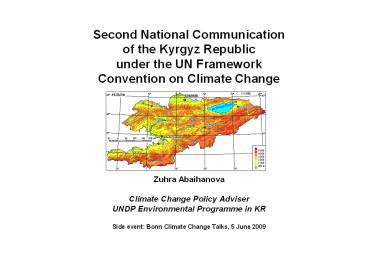Second National Communication - PowerPoint PPT Presentation
1 / 19
Title:
Second National Communication
Description:
Climate Change Policy Adviser. UNDP Environmental Programme in KR ... State of glaciation by 2100. As compared to the Glacier Catalogue of the 60s. ... – PowerPoint PPT presentation
Number of Views:22
Avg rating:3.0/5.0
Title: Second National Communication
1
- Second National Communication
- of the Kyrgyz Republic
- under the UN Framework
- Convention on Climate Change
- Zuhra Abaihanova
- Climate Change Policy Adviser
- UNDP Environmental Programme in KR
- Side event Bonn Climate Change Talks, 5 June 2009
2
Key challenges under the SNC preparation
- Lack of institutional, technical and financial
capacity to - maintain regular GHG inventory process
- provide the long-term climate forecasting
- re-assess the long-term hydro-power potential of
the country - Lack of legal potential to deal with climate
change issues at the sub-national and sector
levels (laws, acts, methodologies) - Insufficient policy-makers awareness and support
to climate change related activities
(adaptation, mitigation)
3
Main outcomes GHG inventory
- Greenhouse gas inventory for 20012005 and
re-assessment of the time period of 1990- 2000 - Sectors
- Energy
- Industrial processes
- Use of solvents and other production
- Agriculture
- Land use, land use change and forestry
- Wastes.
- GHGs CO2, CH4, N2O, HFC,PFC, SF6
- Gases-precursors CO, NOx, NMVOC, SOx
4
GHG emission sum per sectors
5
Total emission of gases-precursors per gases
6
Main outcomes Vulnerability and Adaptation
Observed climate change for
1885-2005, centigrade. According to the
assessment based on the instrumental observations
from 1883 to 2005, an average temperature trend
for the republic made up 0.79? for 100
years. In average, by the end of the century the
air temperature will increase from 4? to
6?. Precipitation will change in the range of
-3 to 2.
7
Vulnerability and Adaptation
- Sectors
- Water resources
- Vulnerability indicators - parameters of
glaciers, volume of the surface water-flow,
parameters of lakes - Agriculture
- Vulnerability indicators - heat availability,
productivity of various types of crops and
pastures - Population health
- Vulnerability indicators morbidity and
mortality rate - Climatic emergency situations
- Vulnerability indicators - frequency of
mudflows, landslides, breaches of
high-mountainous and glacial lakes, avalanches
8
VA Water resources
- Glaciers number
- The 60th about 8200
- 2100 - 142-1484
- Glaciers volume
- 2000 - 420 cubic km
- 2100 - 40-170 cubic km
- Surface water flow
- Current status 47 cubic km
- 2100 - 24 - 33 cubic km
9
State of glaciation by 2100 As compared to the
Glacier Catalogue of the 60s. Extant glaciers
marked with dark blue, the melted marked with red.
10
VA Agriculture
11
VA Agriculture
Crops productivity
Assessment of change trends in the main crops
productivity till 2100 per regions
12
VA Population health
- Vulnerability assessment covered only such
diseases, as - cardiovascular diseases,
- acute intestinal infections, and
- malignant neoplasms.
- Increase in morbidity and mortality rates
connected to cardiovascular diseases, acute
intestinal infections. - Forecast for cancer morbidity revealed the
opposite dependencies (increased for women and
slightly reduced for men). - Groups of risk children and aged people.
13
Expected monthly average morbidity rate for acute
intestinal infections in Bishkek city under two
climatic scenarios (per 100 thousand people)
VA Population health
Expected average annual morbidity rate for
cardiovascular system diseases for Chui region
(per 100 thousand people)
14
VA Dynamics of emergency situations for
expected climate change
15
Main outcome Climate change mitigation
- Assessment of GHG emissions under three
scenarios of the Republics development - A - with no mitigation actions been undertaken,
i.e. with preservation of all existing conditions
and correlations at the national level, but in
view of worldwide tendencies of technologies
development - ? - taking into account the mitigation actions
defined in the national and sector development
plans - ? - taking into account the mitigation actions in
line with the national and sector development
plans, as well as additional actions to be
undertaken within long-term outlook.
16
Estimated cost and expected emission reduction in
2100 from the measures stipulated in the
national and sector development plans and from
additional measures
17
Experience and lessons learnt
- The methodologies for estimation of GHG emission
from the sources not covered by the IPCCC
Guidelines have been developed and used blast
works, antimony and mercury production, secondary
metal fusion inventory time series continued - Assessment of retrospective climate change
tendencies has been done by means of the national
method - method of annual changes analysis and
gave a possibility to use all available
observations.That helped to receive a continuous
line of climate change trends since 1983. - Synergy in collaboration with other relevant
activities in the country and programme approach
have effectively resulted in incorporation of the
SNC developments and recommendations into the
Country Development Strategy and other strategic
development documents at the national,
sub-national and local levels.
18
Recommended studies under the TNC
- GHG inventory time series continued
- Fuller vulnerability assessment for the
population health at the national level ( the SNC
studies are of fragmentary character as cover
separate regions and the capital) - Vulnerability assessment for the sector of
agriculture with a use of modeling methods (i.e.
modeling of crop productivity assessment related
to CC) - Re-assessment of hydro-power potential of the
country in view of the long-term CC forecast, as
well as agricultural needs, water distribution at
the CA regional level, etc.
19
Thank you for your kind attention!

